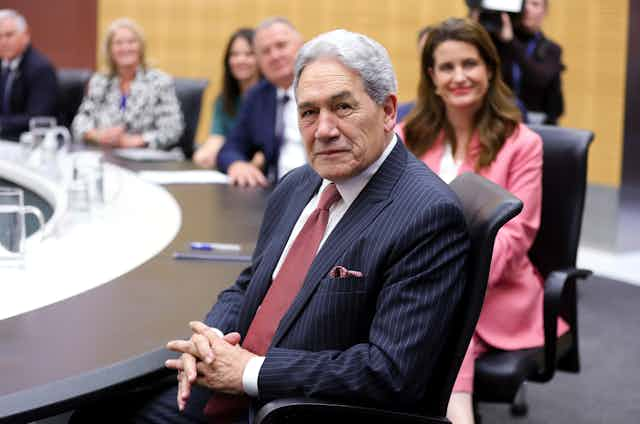Winston Peters had only just been sworn in as deputy prime minister when his long-standing antipathy to the news media emerged in the form of a serious accusation.
Referring to the Public Interest Journalism Fund (PIJF) set up under the previous Labour government (and no longer operating), the NZ First leader claimed “you can’t defend $55 million of bribery”.
He demanded the press gallery “tell the public what you signed up to, to get the money”. And he went on to question the independence of publicly owned media operators TVNZ and RNZ.
His claims have reignited arguments over the merits of publicly subsidised news media. This has already led to one NZ On Air board member resigning over his public reaction to Peters’ comments.
But the controversy is symptomatic of a broader and growing mistrust of the “mainstream” and government-funded media among some sections of the public.
Perceptions of bribery
The PIJF was established as part of the Labour government’s response to the COVID pandemic – which saw a sharp decline in advertising spend. It was a contestable fund administered by state funding agency NZ On Air.
The fund provided NZ$55 million between 2021 and 2023 to support local news initiatives, including journalist roles, specific projects, and industry development and training.
The fund was intended to extend news reporting into areas otherwise not commercially viable – including local democracy, courts, regional and farming issues, and Māori and Pasifika affairs.
Peters’ remarks about “bribery” may reflect his personal unease with the media in general. During and after the election campaign he accused one interviewer of being a “dirt merchant”, “corrupt” and a “left-wing shill”.
But it is also possible Peters has long-standing misgivings about public-funded media mechanisms like the PIJF. While in coalition with Labour as part of the 2017–23 government, NZ First reportedly vetoed an earlier Labour proposal for such a fund, citing concerns it could be misconstrued as bribery.
Misinformation and funding
Being sceptical about what we read or watch is entirely sensible. But wholesale cynicism toward the news – particularly at a time when disinformation thrives on unregulated platforms – can be corrosive to democracy and social cohesion.
Former editor-in-chief of the New Zealand Herald Gavin Ellis reviewed the open justice and local democracy reporting components of the PIJF. He has suggested the disinformation and conspiracy theories that emerged around the fund proved difficult to counter with factual evidence.
Read more: Fake news didn't play a big role in NZ's 2023 election – but there was a rise in 'small lies'
The problem was exacerbated when perceptions of bias or government influence on journalism were used by opposition politicians at the time to attack aspects of the PIJF and its operation.
One of the common themes of misinformation about the PIJF was that it required all bids for funding to conform to an ideologically motivated commitment to the principles of the Treaty of Waitangi.
This arguably flowed from the fund’s general guidelines setting out a number of overarching goals, including: “Actively promote the principles of Partnership, Participation and Active Protection under Te Tiriti o Waitangi acknowledging Māori as a Te Tiriti partner.”
However, this was not a generic requirement for all funding applications.
NZ On Air did commission an external report about what a Treaty-informed reporting framework might look like. This was in response to requests from media interested in applying for funding to cover Māori issues. The report proposed establishing some journalistic principles to address structural racism and colonisation.
Read more: ‘Let them watch Netflix’ – what can be salvaged from the wreckage of the failed TVNZ-RNZ merger?
There’s no doubt this could have been perceived as radical by those already hostile to the Treaty’s place in public life. But crucially, the report was only published in 2022 – and these were not the criteria NZ On Air used to administer actual funding decisions.
The head of funding for NZ On Air has confirmed that not a single PIJF application was declined for failing to meet Māori reporting criteria.
Public policy already affected
NZ On Air has existed since 1989 and has a track record of transparently and independently disbursing contestable public funds. Factual content and current affairs have been funded since 2009.
If the mechanism was prone to government interference, one has to wonder why it has only become a concern so recently.
To conflate a contestable funding mechanism, operating at arm’s length from the government, with the notion that state funding means direct government control, suggests either fundamental misunderstanding or ideological motivation.
Read more: Closures, cuts, revival and rebirth: how COVID-19 reshaped the NZ media landscape in 2020
The PIJF supported over 200 journalist roles, projects and training programmes across the sector. It seems implausible that none would have blown the whistle on government interference if it existed – which would surely have made headlines.
One practical alternative funding mechanism for public-interest journalism would involve imposing a levy on commercial media revenues, particularly the digital platforms which have captured so much of the advertising market.
Ironically, as the cabinet paper behind Labour’s Fair Digital News Bargaining Bill reveals, this was apparently considered by the minister at the time – but rejected in part because of concerns about perceptions of state influence over the media:
Continued financial support for the creation of public interest content through taxpayer funding increases risks around the perceived independence of, and public trust in, the media.
If one is looking for political conspiracy theories, this surely indicates disinformation has begun to affect the scope of public policy. The weaponised dissemination of political disinformation – whether deliberately or through ignorance – is surely the real threat to democracy.

